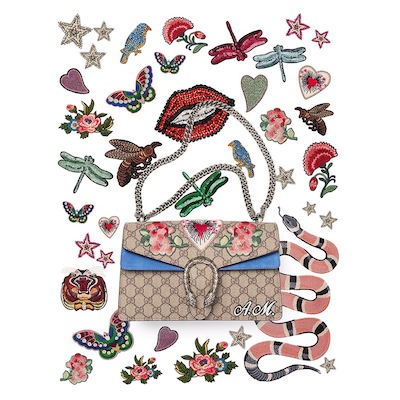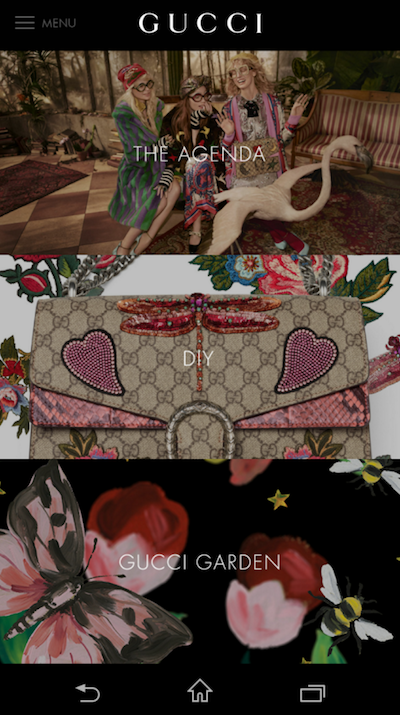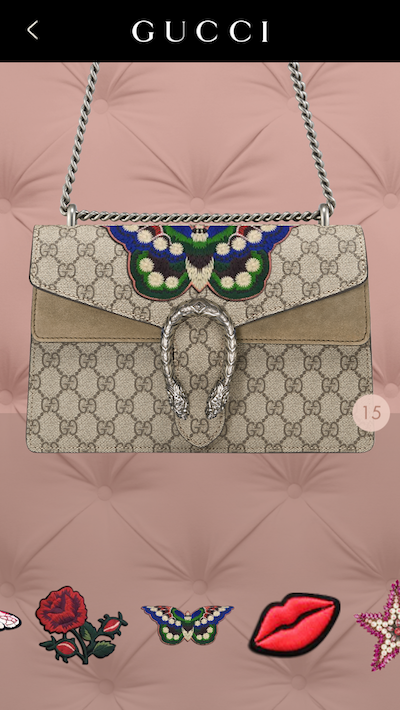Italian fashion label Gucci is embedding its newfound iconography into consumers’ memories through a gamification effort found within its mobile application.
Since taking the reigns at Gucci, creative director Alessandro Michele has introduced a number of motifs such as bumblebees, snakes and various types of flora that have been incorporated into his designs. Quickly becoming the house’s signature, Gucci has used Ms. Michele’s imagery throughout its campaign promotions to present consumers with a consistent brand image as the label undergoes an aesthetic transformation.
“By integrating a gaming factor into the app, the developer is trying to create a stickiness factor, which can help keep users engaged beyond the first session,” said Parisa Durrani, director of mobile strategy at Plastic Mobile, a Havas company.
“Introducing an addicting or sharable game as part of the app, even as a secondary feature, you are giving the user a reason to keep the app in their phone and more chances to explore the app’s other features,” she said.
Ms. Durrani is not affiliated with Gucci, but agreed to comment as an industry expert.
Gucci did not respond by press deadline.
DIY memory test
Gucci has operated a branded app since 2011. In its first versions the app, Gucci’s consumers could browse editorial content and shop featured looks directly from their devices (see story).
Today’s Gucci app is very much the same, but has been revamped to display Mr. Michele’s vision for the brand. When first launched the app automatically begins to play segments from Gucci’s fall/winter 2016 campaign shot in Tokyo (see story).
From the main menu, users can browse “The Agenda” where a list of Gucci’s collections are found, download Gucci Garden wallpapers to their device or discover the #24HourAce sneaker campaign. A fourth option, “DIY,” opens a gaming function inspired by Gucci’s customization program for the Dionysus handbag.
Gucci’s program was launched in May as a way to express Mr. Michele’s philosophy of how the clothing worn by a person represents how they feel. The DIY program will fortify this philosophy by creating authentic and free expression through Gucci products.
The DIY service allows consumers to add a variety of embroideries, trims, hardware and monogram initials on the large- and medium-sized Dionysus handbag.
Consumers can select from Gucci motifs and a number of animals and plants that bring the “Gucci Garden” to life. These include butterflies, lizards, bees, dragonflies, snakes, roses and peonies (see story).
Gucci motifs surround a customized DIY Dionysus handbag
In copy introducing the DIY game the consumer is told that Gucci’s “new memory game lets you play the designer.” A GIF of Gucci motifs cycles through above.
Using the responsiveness of a user’s mobile device, similar to how Chinese social message app WeChat functions, Gucci tells players to remember the patches shown on the Dionysus handbag and to “shake [the device] to start.”
“Taking design cues from one of the most popular apps in the world could be a benefit for Gucci,” Ms. Durrani said. “By drawing parallels between the two apps, Gucci is lessening the learning curve for users, since they may already have a familiarity with similar interfaces.”
When the game begins different Dionysus handbags filter through in quick succession before pausing on a particular design. The user then has three seconds to memorize the patches before 20 seconds is put on the clock.
Players must then slide through the provided motifs and drag the correct ones into position on the handbag. Once the user recreates the example, they are awarded with one of the badges, which can then be shared socially to encourage peers to download to app and play.
Gucci’s mobile app is available for iOS and Android.
Game on
Memory games are a fun and simple way for a brand to promote particular products through a visual medium that is engaging and spurs awareness.
For a 2015 pop-up at British retailer Harrods, Italy’s Fendi created a number of exclusive versions of its handbags and Bag Bugs, which were called Furrods.
To let consumers interact with the display, Harrods created a memory game. Housed in the mobile version of its magazine, the game asked consumers to match up tiles containing images of some of the brand’s handbags.
At the end of the game, consumers had the option to share their score with friends on Facebook or Twitter to compete and compare results. This may have made consumers more likely to complete the game multiple times.
Within the game on the magazine app, consumers could also view larger images of the bags seen in the tiles.
Consumers could either do free-play, which was not timed, or a challenge round where they played against a clock (see story).
Although ideal for driving awareness, sales are not likely to be generated via a gamification effort.
“A bag that costs upwards of $3,500 is very rarely an impulse buy, so the likelihood that the game will trigger the user to order a new bespoke bag is quite low,” Ms. Durrani said. “Also, after successfully completing the game, the user is given the opportunity to share their creation on social media.
“However, there is no direct link to purchase, which creates another barrier to purchase and does not capitalize on their curiosity,” she said. “Lastly, the game is actually quite difficult to win, which could frustrate some users and cause them to exit the app.”
from Apparel and accessories – Luxury Daily https://www.luxurydaily.com/gucci-ingrains-brand-symbols-into-consumer-lexicon-via-in-app-game/
via Your #1 Source to Finding Luxury & Designer Goods, Handbags & Clothes at or Below Wholesale: Click Here.



No comments:
Post a Comment